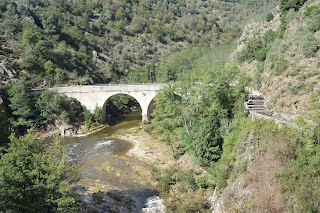One aspect of Gaudras was its proximity to a range of activities. One hour away was a train trip up the Gorges du Doux. Engine 414 (how boring is that – lets call it Percy) was built in 1932 and beautifully maintained.
Just as impressive was the
engineering throughout the trip. How elegantly slender is the arch to this road
bridge?
The gorge also provides
hydroelectricity. Even the race for the water supply required a bridge and very
long open culvert.
The top of the track was a little
town called Colombier where Percy was turned using a hand driven turntable.
And it appeared that some of the carriages leaned to better appreciate the drop off, retaining walls and bridges.
An exhausting trip for some - so time for Percy to go to bed.
An hour North was Lyon. The city is dominated by its wonderful Basilica. There is no mistaking its outline.
The detail inside is even more impressive. This view across the aisle shows one of a series of mosaics with their myriad of tiny tiles. Their range of colours was extraordinary. There were at least 8 of these murals. Fortunately, the number of visitors all contributing at least 2 Euros for their own candle should at least ensure their ongoing maintenance.
Once the walls are absorbed a look to the ceiling is even more mind boggling. Tiling and painting while lying on your back must have been a labour of love.
The view over the city is also
very impressive and although some of the modern-day buildings try to make a
statement, they fall well short of the basilica. The left hand is the
confluence museum (Saone and Rhone) and looks like a repeat of the Bilbao
Gugenheim Museum. The unfinished looking building has been occupied for several
years…
And this is how to change the roof and completely wreck a 19th century building.
The dancing in the adjoining square was much more pleasant viewing
with a couple of onlookers taking in every step.
The Place de Terreaux has a statue built in 1889 which was designed by Frederick Bartholdi (of Statue of Liberty fame). The horses are meant to represent the four main rivers in France. Initially it was designed for Bordeaux but they decided it was too expensive, so Lyon put up their hand. I have to say that the claws on the hooves of the horses and their wild eyes rather detracted from the idea of picturesque rivers.
We also took in a wine tasting. This was in a very similar location to our 2007 experience as the view once more included the nuclear power plant. At least now there is a visitor tasting facility rather than repeating the 2007 challenge to find an accommodating vineyard during harvest time.
A team event requires the team shirt. The tasting was followed by a very pleasant lunch in a nearby village.
Eventually back at the chateau it was time to partake in some of our purchases and watch the moon rise. (This is not a repeat of Star Wars two moons – the second one here belongs to Andrew.)
The chateau was just outside a
lovely little village called Roiffieux. The locals were simply brilliant. First
there was the coffee shop run by Cedric which duplicated as the local bar. Apart
from regular morning coffees we had a wonderful evening watching France v
Namibia while drinking far too much beer with a couple of dozen of the local
younger generation. We engaged in a score tipping competition which I won (as
the instigator it was clearly a just result….!)
There was also the opening of the
local mayor’s office and library with plenty of free drinks, a Celtic band, the
mayor and his wonderful English teacher wife (who was very busy bouncing
between groups translating). This was followed up by three days (yes three
days) of wine tasting by the local Spar owner Philippe. This worked well in his
favour as we all walked out with several boxes of wine for our onwards journey.
Lastly there was a local garden
which we spent a wonderful hour being shown around. The house is dominated by a
round tower. Although on occasions this may have been used for defence its main
role was to attract and house pigeons and hence is called a ‘pigeonarium’.
Although eating the birds and eggs was useful the raison d’etre was to use
their droppings to fertilise the garden.
On one of our last days we decided to explore the local town of Annonnay. There was a guide to the various historic buildings but none really stood out. The exception was this fountain and adjacent road signage which had a natural progression to life as you moved down the list eventually ending up at the cemetery! Of course life then re-starts with a separate sign to family planning!



















No comments:
Post a Comment